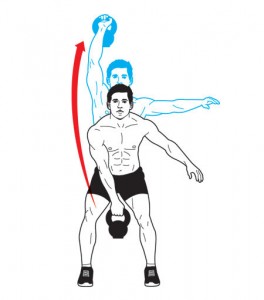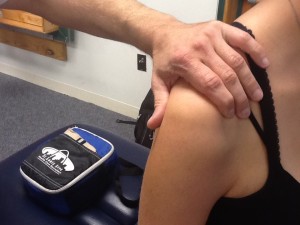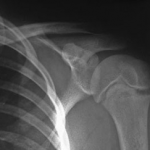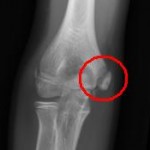Brian Schiff’s Blog
Injury Prevention, Sports Rehab & Performance Training Expert
Soft tissue tightness and restriction in the latissimus dorsi is a common problem in overhead athletes, throwers, weight lifters and Crossfit participants. I often educate clientele on self myofascial release techniques using a trigger point ball or foam roller. But, I also like using a partner technique with the Stick.
Begin in standing grasping the frame of a squat rack. You may also elect to hold both handles of a TRX. Next, slowly squat down and lean back allowing the shoulders to move into flexion. Once in position, the trainer or workout partner will use the Stick to apply pressure and roll up and down along the latissimus especially working on the soft tissue near the shoulder.

Perform this technique for 30-60 seconds and then switch sides. Adjust pressure and location based on feedback from the client.
In the past, I wrote a post about Crossfit and shoulder pain based on a 38 y/o male client of mine. Click here to read that post. In my prior entry, I discussed differential diagnosis of rotator cuff and labral pathology, as well as my treatment approach for that client.
If you follow my blog, twitter feed or webinars, you know I treat a lot of Crossfit athletes. Recently, I worked with a 25 y/o female suffering from marked shoulder pain that was keeping her out of the gym.

Below are the key findings from her intake on 8/30/13:
- Onset of left shoulder pain on 8/8 related to snatches
- Right hand dominant
- Intermittent pain if sleeping on her left side
- Full AROM
- Mild weakness with supraspinatus and external rotation on left
- Positive impingement signs
- Positive O’Brien’s test (labral test)
- Positive sulcus sign bilaterally (indicates multi-directional instability or MDI)

Sulcus sign
Treatment intervention
- Rhythmic stabilization and PNF exercises
- Rotator cuff and scapular strengthening
- Closed chain stabilization training
- Game Ready (cryotherapy)
- Home program issued at visit #1
I saw the patient once per week and she did her home program for 4 weeks. At week 4, we gradually began allowing her to do some modified gym workouts but still no snatches or full overhead work. She was pain free at this time and all impingement/labral signs had resolved. At this point she returned to some wall ball drills (limited height) but still no snatches.
The client’s final visit was on 10/2/13. Her Quick Dash percentage of perceived shoulder dysfunction was now 0%. She was symptom free, but more importantly she had a great understanding of how to modify her lifts, loads and volume based on her multi-directional instability. She was now aware of how her instability impacts her shoulder in “at risk” positions and in the face of fatigue. This brings me to the primary reason for this second post related to Crossfit and shoulder pain.
In my initial post, I focused on overuse and shoulder inflammation as a result of poor mobility, muscle imbalances and a lack of physical preparedness to do high intensity exercise like Crossfit. On the other end of the spectrum lies the unstable shoulder.
Hypermobility and/or shoulder instability is a major problem for those doing Crossfit in light of the following:
- Many lifts and exercises put the shoulder in “at risk” positions
- Poor glenohumeral joint stability places more stress on the rotator cuff and long head of the biceps
- With the AMRAP approach and train to failure nature of the WOD, fatigue is a given and this means the stabilizing muscles that matter most will often fail leading to a much higher injury risk
Key Takeaways
- My client had secondary rotator cuff and bicipital irritation related to primary instability
- Rest and a combined stabilization and cuff/scapular strengthening exercise program was effective in resolving her symptoms within 30 days
- High load/high volume overhead lifts and those that place the shoulder at end range pose a higher injury risk for those with MDI or anterior instability
- Shoulder stability work trumps mobility work in those with shoulder instability – this often runs counter to traditional approaches that tend emphasize better mobility (one program does not fit all)
Closing thoughts
We must keep in mind that the shoulder is inherently unstable in order to allow us the freedom of movement necessary to perform the various tasks and exercise. With that said, repetitive movements and lifts can create micro and/or frank shoulder instability over time. Those with a history of shoulder subluxation/dislocation/instability are a high risk group to begin with. Adding high loads to failure places the shoulder in a fatigue and compromising state. As a coach, competitor or health professional, we must remember that even the best intentions and coaching can fail us if the risk of a lift outweighs the reward.
As I have said before, anyone who decides to do Crossfit MUST get a proper assessment prior to starting to reduce injury risk. Ideally, this assessment would begin with a full FMS to help uncover any mobility or stability issues and asymmetry. Keep in mind research reveals that females will almost always score a 3 on shoulder mobility and many may be hypermobile. Conversely, they tend to score lower (1 in many cases) on the trunk stability push-up. Any pain with screening would necessitate a referral to a PT or MD for further evaluation.
Trainers cannot be asked or expected to catch multi-directional shoulder instability. However, they can and should be aware of relative risk, anatomical tendencies and red flags that may predispose clients to injury. For those wanting to be the best in the business, I would suggest developing a system for assessing clients and partnering with allied health professionals like me to incorporate best practices in their business. Perhaps most importantly, trainers and coaches must be willing to adapt, limit, or eliminate exercise that does not fit the needs and abilities of the clientele.
The random nature of the WOD makes it difficult for unassuming clients to judge how best to fit in the Crossfit model if they have a dysfunction or injury concern. My goal is always to empower people with knowledge about their body and sound advice for optimal training. For those intent upon getting back to Crossfit after injury, I work hard to normalize their function and offer tweaks and modifications to prevent re-injury. Prehab is a must for this population. But in the end, some shoulders will simply not be able to handle the rigors and intensity of Crossfit.
I like to include exercises on this blog that are useful for rehab and fitness professionals as well as fitness enthusiasts who visit. This is a cool exercise that a colleague taught me. I also recently shared this as part of my ‘Functionally Fit’ column for PFP Magazine. It works great when doing partner workouts or if coaching a client. We used it during our off season training for the Carolina Hurricanes and it is much harder than it looks on the surface.
Training clients to maintain core stiffness in athletic functional positions will improve performance and reduce injury risks for the spine and lower extremities. This exercise is an effective way to address postural stability, increase core strength and enhance kinetic chain proprioception

Execution
Begin in a split squat position holding a stability ball overhead. The client maintains an isometric split squat while the coach/trainer provides directional perturbations in an attempt to disrupt balance and stability.
You may opt for several quick rhythmic perturbations or elect to use more sustained pushes (1-2 seconds in each direction) to challenge the client. Allow the client to reset to the desired position if he/she does lose balance in order to facilitate optimal motor patterning. Perform 30 seconds with the left leg forward, rest 30 seconds and then repeat with the right leg forward. Complete two sets on each side.
Be sure to observe asymmetries or deviations specific to either side as this will allow for better cuing and reveal energy leaks. Marking the desired distance between the front heel and rear foot toes with tape will ensure consistency for each trial side-to-side.
So, one of my biggest pet peeves as a PT is seeing athletes hurt as a result of poor coaching and training. Overuse injuries provide lots of clients for my practice. While this is good for business, I would really like to help prevent these injuries. I need your help. It all starts with education and a willingness on the part of health and fitness professionals to advocate strongly for our young athletes.
Consider the following scenario: a 14 y/o freshman left-handed pitcher presents for rehab to recover from Little League Shoulder. He was hurt on the second day of his high school’s fall conditioning program. He was being forced to throw in excess of 200 feet. His exact words were, “I was sore after day one, but I felt my shoulder explode on the second day of the program.” Think this is a coincidence? Hardly.
Another player from the same school (a sophomore right hander) is also in my clinic recovering from an avulsion fracture of his medial epicondyle that he too suffered on the second day of the same throwing workout. I emailed the left-handed pitcher’s father with details about throwing biomechanics and how they decline with long distance throwing. I also expressed my concern over the coach’s aggressive throwing program. The father emailed back and said he too disagreed with the throwing program. However, the coach simply told him his son had “not been properly coached” prior to getting to his program. Are you kidding me? Look at the images below to appreciate the type of damage done by overzealous throwing programs.
Coaches need to be more accountable to their training programs and philosophies. Both of these players are missing no less than 3 months of baseball because the coach is clueless about the impact of aggressive long toss and how it may actually be detrimental to his players as opposed to actually improving their throwing technique/performance.
Click here for an article summary in JOSPT related to throwing biomechanics
So, how do we make a positive impact and prevent unnecessary injuries like the ones I have discussed? I feel we need to look at the following strategies:
- Educate parents and coaches through talks and seminars
- Network with high school athletic trainers to ensure they have some feedback/input with respect to preventive training philosophies as well as a direct pipeline to coaches
- Reach the athletes directly through arm care screenings, FMS evals and professionally directed throwing programs
- Team with high profile baseball players or coaches who understand the game at the highest level and will spread the message in a positive and constructive manner
- Participate in CEU course for coaches and present on throwing programs, shoulder strengthening and mobility training
Based on these two cases, I am brainstorming ways I can become more of a “voice” in the baseball community in my area. It is tough to convince pushy parents and misguided coaches that young kids don’t need to throw curveballs or that pitchers should probably not be forced to throw over 200 feet in hopes of increasing arm velocity. But, we need to step up and make a difference or more young kids will be suffering from tendinitis, Little League Elbow/Shoulder, labral tears or other overuse injuries.
Click here for an abstract reference with respect injury risk and innings pitched per year
As a father, coach, educator and physical therapist, my personal mission is to make a difference in the lives of those around me. I know many may simply be unaware that there is a better or safer way. As the emphasis on early specialization continues to grow in our country, now is the time to take action and help stop many of these injuries.
I readily admit I have had an aversion to abdominal exercises that involve straight leg lowering since my days in pee wee football where we were forced to do lifts and holds a few inches above the ground. Some will relate to a modern day version of this exercise known as “six inches.”
As someone with tight hip flexors and who has personally suffered from sciatica in the past, I am NOT a fan of abdominal training that exposes the lumbar spine to large loads and undue risk related to exercises that involve long levers (e.g. throw downs, scissors, etc) and place high shear force on the spine.
I was reminded of why I feel this way in a fitness class this past week. I take a cycle/core class at my local gym and have done a traditional spinning class twice per week for 3 years. After 45 minutes of cycle, we move to a fitness room for core. I have done this new format for three weeks. This week we were asked to do a series of exercises which included “banana rolls.” If you are unfamiliar with this move, check out You Tube for some video demos.
While this exercise may be effective for core strengthening, I can honestly say as one who has never done the move before that trying to execute it as part of a continuous sequence of movements without rest between the moves was very hard to do with proper form. The fatigued state encouraged using momentum and straining to simply get the movement done (not to mention the fact my greater trochanter was sore from the rolling on the hard aerobic floor).
The next day I woke up with low back pain. My back has not hurt like that in years. In light of the role the iliopsoas plays by virtue of its attachment on the lumbar spine, we must consider the impact of reverse muscle action and how it creates shear on the lumbar spine during movements that rely on stabilization with the legs extended against gravity. Additionally, for those clients like me with muscle tightness, increased lumbar lordosis and a history of low back disorders, health and fitness professionals must consistently evaluate safety and efficacy as well as trying to challenge clientele in a workout session.
For all of these reasons, I increasingly rely on neutral spine anti-extension and anti-rotation training exercises in my programming for athletes and clients of all ages and abilities. That is not to say I never do rotational or active movements. They are appropriate given the right order, progression and demands of the respective individual. I just think we must consider form and risk versus reward in exercise programming.
The exercise video below illustrates how to use sliders in a tall plank position to accomplish great core activation and hip/shoulder stability without stressing the lumbar spine with long lever movements. Keep in mind that quality should override quantity in terms of deciding repetition schemes. Do not let the desire to fatigue clients cause form to suffer as this may increase injury risk.
For more specifics on the execution and progression/regression of this particular exercise, click the link below to read my most recent exercise column for PFP Magazine.
Suffice it to say I will not be doing banana rolls again. While I am not completely discarding the exercise, I do think it should be done in a non-fatigued state and taught incrementally if done at all. Most importantly, we as fitness professionals must always remember to program exercises based on fatigue and skill level, while carefully weighing risk versus reward in group or individual sessions.



